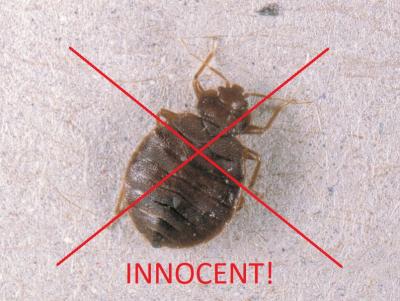Last month I wrote about the problem of identifying who was at fault in cases of rented property and bed bug infestations. During the blog I alluded to the problem of ‘phantom biters’, something every pest controller has had to deal with at some time or other, and I thought this might be a good topic as Halloween approaches.
‘Phantom biters’ is a term we use when a pest control technician is called to a property with reports of insect bites but, no matter how hard they look, they can find no evidence of biting bugs. In the bad old days, the pest controller might have used a ‘placebo’ spray to try to placate the ‘sufferers’. This is not only bad for the environment, it is also a waste of time as research has shown the ‘infestations’ always return with the pest controller being blamed. In the blog, I also pointed out how these ‘infestations’ nearly always return because the problem is in fact emblematic of another issue and, since that has not been dealt with, the ‘phantom biters’ will free to return.
It is a phenomenon that is not restricted to the home. The same symptoms are also reported in the workplace. In fact, it is remarkable how the same symptoms are seen in nearly every case and they are found all over the developed world. In the UK, it started to become a major problem in 1977 and has continued ever since. A recent study of high street retailers showed that younger people (20-30) were more likely to complain and that 63% of all attacks occurred on the legs.
When someone reports a bite, the natural response for many people is to blame a bug because all bugs bite, right? In fact, very few bite. Part of the problem is that all bites appear to be very similar – red itchy bumps, which can swell. For the pest controller, however, this is not very diagnostic, as many other causes of skin irritation create exactly the same marks.
It must be remembered we are all different and our bodies react to things in very different ways. Everyone has a different susceptibility to biological, chemical, or physical agents, so what is assumed to be a bed bug infestation may actually be a change in washing powder or a new air filter discarding microscopic fibres on its first run.
When a technician is first called to a case of ‘biting’ they will often find no evidence of an infestation. In some cases, the owners may even collect bugs they consider to be the culprits but which are in fact harmless insects. In fact, there are five basic possibilities when trying to answer the question of ‘what is biting?’
Firstly, there may be biting bugs in the home or workplace. A trained pest controller will know where to look and how to identify the cause. Common troublemakers are bed bugs, bird mites, lice, fleas, and even some forms of mosquito. As I write this article, there has just been reported yet another case of bed bugs on a plane. This isn’t the first time and I’m sure it won’t be the last.
Secondly, there are insects that don’t bite but which can cause reactions in humans. For example carpet beetle larvae have tufts of hair that are shaped like arrow heads at the end. These can pierce human skin, causing irritation. In another example, canteen staff sometimes complain of ‘grocer’s itch’ which is caused by food mites. There is even the possibility that what are being identified as bites are actually irritations caused by human itch mites, also known as scabies.
The third possibility is that the bites are real but the pest controller can’t find a cause because the culprit is actually resident away from the home or workplace. Not all bites have immediate responses. For example, a cat flea bite can take between three to four days to appear. It is not surprising, therefore, that the pest controller finds it difficult to identify the cause of the infestation.
The fourth and fifth causes are the most difficult for the pest controller to deal with because they have nothing whatsoever to do with bugs. This is where an individual’s own propensity to react to external factors can really come into play. Our everyday lives are surrounded by potential contaminants, each with the ability to cause an irritation that may appear to be a bite. These include air pollution, bio-effluents, building materials, for example fibre glass, carpet fibres, clothing, cosmetics, soaps and detergents, dirt in carpets and upholstery, and even static electricity generated on VDUs. Each of these can be reported as ‘bites’ in those that are susceptible.
The fifth and final cause of ‘phantom biters’ are things we generate ourselves. Stress, acute anxiety and conflict between two parties have all been known to trigger mystery bug attacks. There is even a psychosis known as delusory parasitosis, or monosymptomatic hypochondrial psychosis - an unshakeable belief that you are being attacked by insects. Less common in the workplace than the home, this is generated in the mind and will even lead to the sufferer collecting ‘evidence’ – often flakes of skin, floor debris or wool rubbings.
Also in this final category, the pest controller must always have in the back of his head that what is being seen is ‘I’ve got that’ syndrome. It is possible for one person to complain of a bite, possibly a cat flea bite received at home. When they go to work and complain about it, mysteriously co-workers also start to complain and suddenly the workplace is ‘infested’. The power of suggestion should not be underestimated and, even as I write this, I can feel a tingle on my skin as if I’m being bitten....
